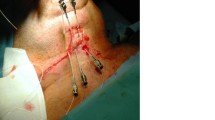Background and Purpose:
To date none of the studies examined the feasibility and efficacy of interstitial high-dose-rate (HDR) brachytherapy in the treatment of carcinoma of the tongue base. Therefore the aim of this study was to contribute to this issue.
Patients and Methods:
Between 1992 and 2000 37 patients (mean age 55 years) with T1–4 and N0–3 carcinoma of the base of tongue were presented. Neck dissection was carried out in twelve cases (32%). 30 patients with advanced stage received brachytherapy boost after 50–66.5 Gy (mean, 60 Gy) locoregional external beam irradiation (EBI) and 7 patients with early stage (T1–2, N0) were managed locally with wide tumor excision and sole brachytherapy. 4 of them underwent neck dissection and the others were subjected to 50 Gy regional EBI. The mean dose of boost and sole brachytherapy was 18 Gy and 28 Gy, respectively.
Results:
The median follow-up time for surviving patients was 51 months. The 7 sole brachytherapy patients are living with no evidence of disease. For patients treated with EBI and brachytherapy boost, the 5-year actuarial rate of local, locoregional recurrence-free and overall survival was 60%, 52% and 46%, respectively. For all patients in univariate analysis larger tumor size (T4 vs. T1–3) was significant negative predictor of local (RR: 7.23) and locoregional control (RR: 3.87), but nodal involvement was not. Delayed soft tissue ulceration and osteoradionecrosis occurred in 4 (13%) EBI and brachytherapy treated patients. None of the sole brachytherapy patients experienced severe late radiation toxicity.
Conclusion:
EBI combined with interstitial HDR brachytherapy boost result in acceptable local tumor control with low incidence of late side effects in patients with advanced disease. Fractionated sole HDR brachytherapy following tumor excision is a feasible treatment option for patients with early stage cancer and gives excellent local results.
Hintergrund und Ziel:
Zurzeit liegt keine internationale Studie vor, die die Anwendbarkeit und Wirksamkeit der interstitiellen High-Dose-Rate-(HDR-)Brachytherapie in der Behandlung des Zungengrundkarzinoms untersucht. Ziel dieser Arbeit ist es, unser Petientenkollektiv retrospektiv zu analysieren und unsere Therapiestrategien vorzustellen.
Patienten und Methode:
Zwischen 1992 und 2000 wurden 37 Patienten (Durchschnittsalter: 55 Jahre) mit Zungengrundkarzinomen im Stadium T1–4 N0–3 behandelt. In zwölf Fällen (32%) wurde eine Neck Dissection durchgeführt. 30 Patienten im fortgeschrittenen Tumorstadium erhielten nach lokoregionaler externer Bestrahlung (EBI) mit 50–66.5 Gy (durchschnittliche Dosis 60 Gy) anschließend einen Brachytherapie-Boost. Bei 7 Patienten im frühen Tumorstadium (T1–2, N0) wurde nach weiter Tumorexzision eine alleinige Brachytherapie durchgeführt. Im Anschluss daran erfolgte in vier Fällen eine Neck Dissection; die übrigen erhielten eine lokoregionale EBI bis 50 Gy. Die durchschnittliche Boostdosis bzw. alleinige Brachytherapiedosis waren 18 Gy und 28 Gy.
Ergebnisse:
Die mediane Nachbeobachtungszeit betrug 51 Monate. 7 Patienten, die mit alleiniger Brachytherapie behandelt wurden, leben seither tumorfrei. Die Rate bezüglich der 5-jährigen lokalen, lokoregionalen Rezidivfreiheit und der Gesamtüberlebenszeit bei Patienten, die mit EBI und Brachytherapie-Boost behandelt wurden, betrug 60%, 52% bzw. 46%. Eine univariate Analyse konnte zeigen, dass das Tumorvolumen (T4 vs. T1–3) für alle Patienten ein signifikant negativer Prädiktor bezüglich der lokalen (RR: 7,23) und lokoregionalen Tumorkontrolle (RR: 3,87) war. Dies galt nicht für die Lymphknoteninfiltration. Als Spätfolgen traten bei 4 Patienten (13%), die mit EBI und Brachytherapie behandelt wurden, ein Weichteilulkus und eine Osteoradionekrose auf. Bei Patienten, die mit einer alleinigen Brachytherapie behandelt wurden, traten keine Spätnebenwirkungen auf.
Schlussfolgerung:
EBI gefolgt von interstitieller HDR-Brachytherapie führt zu einer annehmbaren lokalen Tumorkontrolle bei Patienten mit fortgeschrittenen Karzinomen, wobei das Risiko chronischer Spätfolgen gering ist. Karzinome im Frühstadium profitieren von der lokalen Tumorexzision gefolgt von fraktionierter HDR-Brachytherapie. Es werden damit ausgezeichnete lokale Ergebnisse erreicht.
Similar content being viewed by others
Author information
Authors and Affiliations
Corresponding author
Rights and permissions
About this article
Cite this article
Takácsi-Nagy, Z., Polgár, C., Oberna, F. et al. Interstitial High-Dose-Rate Brachytherapy in the Treatment of Base of Tongue Carcinoma. Strahlenther Onkol 180, 768–775 (2004). https://doi.org/10.1007/s00066-004-1238-x
Received:
Accepted:
Issue Date:
DOI: https://doi.org/10.1007/s00066-004-1238-x




